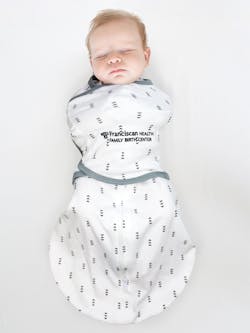How hospitals can provide better, safer sleep for mom and baby
Over the past several years, many hospitals have updated their Safe Sleep programs to include in-hospital modeling of safe sleep and a take-home gift like a swaddling sack that helps the parents swaddle at home. This approach, combined with improved Safe Sleep educational material, increases the likelihood that new parents will recall, understand, and use safe sleep guidelines when they return home.
Recently, hospitals have decided to refresh and update their Safe Sleep program as they strive to maximize the impact of their program. They realize that parents are overwhelmed during their hospital stay, and it is important to extend the educational program to the home. By providing a Safe Sleep take-home gift, they are providing a helpful tool and visual reminder of the hospital safe sleep educational material.
The programs are designed to educate parents about the American Academy of Pediatrics (AAP) Safe Sleep Guidelines and teach important newborn calming techniques including how to swaddle, so everyone can get more sleep.
To examine the benefits of empowering parents with useful skills and tools, while minimizing fatigue and sleep deprivation, we discuss the advantages of this approach with Lynette Damir, an RN in Seattle, Washington and Founder & CEO of SwaddleDesigns.Q: How serious an issue is parental sleep deprivation on returning home with their newborn babies?
Families where the baby is not sleeping well struggle because when baby is not sleeping well, nobody sleeps well. New parents need to learn how to properly swaddle a baby, because swaddling reduces frequent awakenings due to the Moro (startle) reflex. Studies have proven that babies sleep longer and better on their back when swaddled.
Sleep deprivation and exhaustion are the primary complaint of new parents. Experts understand that parent sleep deprivation can lead to unsafe choices, increased postpartum depression and shaken baby syndrome. Exhaustion combined with a crying baby impairs judgement and can lead parents to make unsafe choices such as bringing baby to bed with them, which significantly increases the risk of suffocation and SIDS. Or, they might opt to put baby on their stomach, which also significantly increases the risk of SIDS.
Given that 3,500 babies die annually in the United States as a result of SIDS, SUID, and suffocation, it is extremely important for hospitals to implement programs that reduce the likelihood that a parent will make unsafe sleep choices. While there is no way to prevent SIDS, there are AAP guidelines designed to reduce risk of SIDS, SUID and suffocation.
Q: What role can hospitals play in helping parents learn Safe Sleep practices?
Studies have shown that parents remember and mimic what nurses do at the hospital. So, modeling safe sleep behaviors and using an easy, safe swaddling approach is important. As a result, many hospitals implement Safe Sleep Modeling Programs in the birth center and NICU. Staff training is a critical element of the program. In addition to educational material provided to parents, the Safe Sleep programs often include swaddling garments as departure gifts.
In many hospitals, babies are placed on the mother’s chest for the first hour or two, and then swaddled and placed on their back in a bassinet or an isolette near the mother’s bed to give the mother time to sleep, and help with temperature regulation as the baby transitions from the womb to the world. Because nurses are viewed as experts, they can help teach and role model the safest sleep practices, and illustrate what parents are learning in the educational materials provided.
Q: Hospitals have traditionally swaddled newborns with blankets, but a growing number are moving to wearable blankets with swaddle wraps. What is the advantage of this new approach and an example of its use?
Many hospitals have stopped using traditional hospital receiving blankets to instead swaddle newborns in wearable blankets with swaddle wraps to make it easier and safer for new parents.
Q: Are there specific design features that are important in a swaddling garment?
A well-designed swaddling garment should support many natural arm and hand positions. Sleeves that come with foldover mitten cuffs, when open, allow baby to self-soothe and, when closed, protect against facial scratches. When the mitten cuffs are closed, the sleeves should hold the baby’s flexed arms close to their body. If baby prefers arms up, then the sleeves should cover the baby’s arms.
To support hospital safe sleep initiatives, there are special versions of swaddling garments for in-hospital use. Typically these come with nylon snaps instead of a zipper to allow hospital personnel to x-ray without undressing baby.
Q: What role are hospitals playing in providing parents with a properly vetted Safe Sleep education that stands apart from common misinformation?
In addition to modeling safe sleep and swaddling for babies, hospitals play a vital role in providing parents with the best available sleep education.
There is much misinformation posted online, as well as advice from well-meaning family members that may have outdated concepts of baby care not aligned with best practices or current safety standards.
So, hospitals are also updating their Safe Sleep educational materials to include the “3 Stages of the Safe Sleepwear” guide to help parents understand the importance of the transitional phase between swaddling and the time baby is ready for loose-fitting wearable blankets.
It is important that the baby continue to sleep well during this transition time. The AAP recommends parents stop swaddling baby with arms restrained in a classic snug swaddle at 2-3 months or when baby shows signs of attempting to roll over.
However, at three months, some babies may not sleep well in a loose-fitting wearable blanket and may need some suppression of the Moro reflex.
When baby is not sleeping well, parents are more likely to try unsafe sleep practices such as continuing to swaddle or bringing baby into bed with them, which increases the risk of SUIDS, and suffocation.
A solution, a Transitional Swaddle Sack can help parents navigate this difficult period. The special sleeve design can moderately suppress the Moro reflex, and yet this design allows baby to use their arms to lift their torso and reposition their head, if they roll over.


